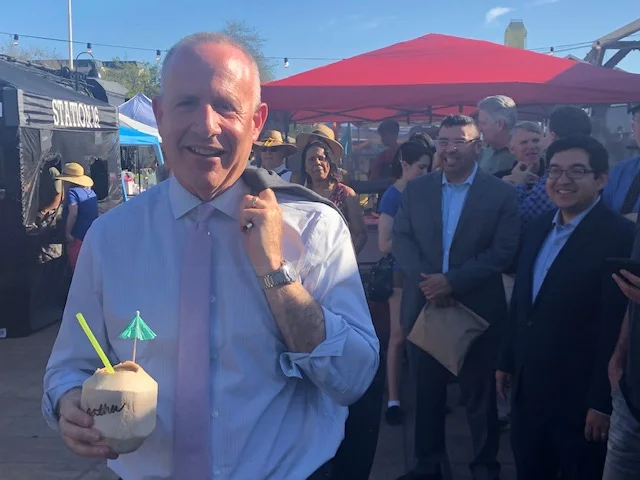Mayor Steinberg announces $42 million plan to revamp Old Sacramento Waterfront
Mayor Darrell Steinberg Thursday announced a $42-million plan to reinvigorate the Old Sacramento Waterfront, funded by hotel taxes left over from the Convention Center and Community Center Theater project.
New attractions proposed by the city’s economic development staff include a waterfront park with a lawn for festivals and concerts, an interactive fountain and an adventure playground for kids. The Sacramento History Museum would be topped with a roof deck that could host events. A nearly vacant public market building erected in the 1990s that blocks Old Sacramento from views of the water would be torn down and replaced with a two-story “Freight Depot” that would be open to the river on the bottom and have food and drink venues on the second floor.
Mayor Steinberg with Richard Rich, the City’s Riverfront Project Manager
Floating terraces in the river could host more events and dining options, and could even feature a floating pool.
The waterfront plan will go to City Council on Tuesday.
“Great cities use their rivers, they take advantage of their natural assets to grow tourism and jobs, nature spots and nightspots, and create buzz inside and outside their cities,” Mayor Steinberg said.
He made his announcement in front of a crowd that came to Old Sacramento to enjoy a pop-up Gather festival sponsored by All about Sacramento, the Downtown Sacramento Partnership and Visit Sacramento, and staged by Unseen Heroes. The festival was held on the new Embarcadero along the water, which was opened by the city last spring to improve disabled access to the waterfront.
Mayor Darrell Steinberg at Waterfront Gather. In background are Councilmember Eric Guerra (right) and Michael Jasso, assistant city manager.
Mayor Steinberg noted that the hotel tax funds can’t be used for general city needs or to address issues like economic inequity or homelessness. The law requires that the taxes be used for public assembly amenities that will create more hotel taxes in the future.
“Investing in Sacramento’s neighborhoods and getting people off the streets are my top priorities as mayor, something I work hard on every day,” Mayor Steinberg said. “But to be a healthy city we also have to create economic generators like a revitalized waterfront, which will produce more business and ultimately more tax dollars for us to pay for city services and address problems like homelessness and affordable housing.”
This slide shows where new attractions would go and what they could look like.






